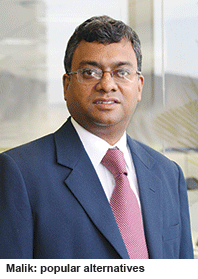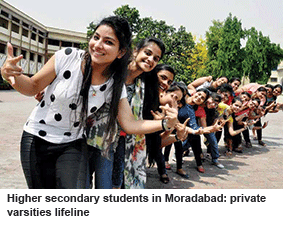In a departure from past practice in which we presented perceptual rankings of the country’s Top 200 public and private universities together and ranked them inter se, this year we have opted to rate and rank the Top 100 private universities, engineering colleges and B-schools Dilip Thakore
.gif) This year EducationWorld’s annual summer rankings of India’s best private universities, engineering colleges and B-schools comes hard on the heels of the country’s first ever official higher education institutions rankings published by the Union human resource development ministry on April 4. For several years, when confronted with awkward questions about why none of the country’s 389 public and 355 private universities strictly governed and regulated by supervisory government organisations such as the University Grants Commission and All India Council for Technical Education, figure in the Top 200 World University Rankings of London-based Quacquarelli Symonds and Times Higher Education or even of Shanghai Jiao Tong University, the standard official reply was that the evaluation parameters of foreign agencies are inappropriate for assessing India’s sui generis institutions of higher education.
This year EducationWorld’s annual summer rankings of India’s best private universities, engineering colleges and B-schools comes hard on the heels of the country’s first ever official higher education institutions rankings published by the Union human resource development ministry on April 4. For several years, when confronted with awkward questions about why none of the country’s 389 public and 355 private universities strictly governed and regulated by supervisory government organisations such as the University Grants Commission and All India Council for Technical Education, figure in the Top 200 World University Rankings of London-based Quacquarelli Symonds and Times Higher Education or even of Shanghai Jiao Tong University, the standard official reply was that the evaluation parameters of foreign agencies are inappropriate for assessing India’s sui generis institutions of higher education.
The unique parameters of inclusivity and outreach are duly included in the ministry’s parameters (others: teaching, learning and resources; research, consulting and collaborative performance; graduation outcome; and perception) grouped together under a National Institutional Rankings Framework (NIRF). “Country-specific parameters relevant to the Indian situation include regional and international diversity, outreach, gender equity and inclusion of disadvantaged sections of society,” says Union HRD minister Smriti Zubin Irani in the preface to the Central government’s inaugural India Rankings 2016 which rates 2,734 universities, engineering, business management and pharmacy colleges countrywide. “The rankings framework will empower a larger number of Indian institutions to participate in the global rankings, and create a significant impact internationally too. I see this as a sensitisation process and an empowering tool, not a tool for protection,” she adds.
Although over two years of official labour have been invested in devising NIRF, the methodology of assessing the country’s best higher education institutions is questionable. The rankings are based upon data submitted by the ranked institutions themselves which is likely to be tweaked, if not exaggerated. And although HRD ministry spokespersons claim that the data submitted has been checked and validated, it’s obvious the validation exercise has been conducted in typically slapdash government style.
 This explains the patent absurdity of the University of Tezpur, Assam being ranked #5, a notch above Delhi University; Visva-Bharati, Shantiniketan, which is in terminal decline being ranked #11 and Jamia Hamdard, an institution dispensing ayurvedic and unani medical education being ranked #18, while the nationally renowned Jamia Millia Islamia University, Delhi is ranked a lowly #83. Quite obviously in typical government style, the names of the two universities were mixed up.
This explains the patent absurdity of the University of Tezpur, Assam being ranked #5, a notch above Delhi University; Visva-Bharati, Shantiniketan, which is in terminal decline being ranked #11 and Jamia Hamdard, an institution dispensing ayurvedic and unani medical education being ranked #18, while the nationally renowned Jamia Millia Islamia University, Delhi is ranked a lowly #83. Quite obviously in typical government style, the names of the two universities were mixed up.
Worse, highly regarded Central institutions such as FMS, Delhi, and the Delhi Technological University, routinely ranked among the country’s Top 10 B-schools and engineering colleges in all media surveys, are not ranked at all. The S.P. Jain Institute of Management & Research, Mumbai, regularly ranked among the country’s Top 10 B-schools which has established campuses in Singapore and Dubai (average placement salary: Rs.18 lakh per year), is ranked below the Thiagarajar School of Management, Madurai (average placement salary: Rs. 5 lakh). Indeed, the HRD ministry’s league tables are reminiscent of the voters’ rolls produced by state and municipal governments replete with unverified spelling and address errors.
“Despite two years of lead time and all the resources of the Union government at its command, the HRD ministry’s inaugural universities, B-schools and engineering colleges league tables display drastic inconsistencies, are shockingly misleading and have damaged the reputation of several of the government’s own universities and institutions of higher education. Far from creating an international impact as the HRD minister hopes, the new official university rankings have made the government a laughing stock. It’s a clear case of fools rushing in where angels fear to tread,” says a market research veteran, interviewed on condition of anonymity.
This is the backdrop against which we present the annual EducationWorld 2016 Rankings of the country’s best private universities, B-schools and engineering colleges. In a departure from past practice in which we presented perceptual rankings of the country’s Top 200 public and private universities together and ranked them inter se, after considerable deliberation this year we have chosen to beam the spotlight on private universities and institutions for several reasons.
First, with most publications (India Today, Outlook, Careers 360 and several business magazines and dailies) publishing league tables of public and private institutions of higher education without differentiation, we discerned a sense of déjà vu and reader fatigue with such surveys. Secondly, with the same heavily-subsidised government institutions — Indian Institute of Science, Delhi University, 23 Indian Institutes of Technology and 19 Indian Institutes of Management — dominating the league tables of all media publications year after year, there was much of a sameness in their surveys. Thirdly, India’s vintage public universities and higher education institutions owe much of their popularity to academic head-starts, over-subsidisation of tuition fees and generous government grants made at the expense of foundational early childhood and primary education. Despite this the country’s 389 public universities, some of whom were established 150 years ago, have precious little to show by way of research and innovation or spectacular learning outcomes. 
For all these and other supplementary reasons, it made more sense to focus the searchlight on the country’s estimated 355 private universities, 2,400 B-schools and 2,775 engineering colleges which host 65 percent of the 27 million youth in higher education. In this context, it’s pertinent to note that India’s private institutions of higher education have established their reputations the hard way, having had to cut through the jungle of red tape devised to discourage private initiatives in education, myopic judicial intervention and without the soft option of government subsidies.
The majority of Left academics who dominate the academy tend to be contemptuous of private universities because they levy cost-related tuition fees — anathema to Left intellectuals who see nothing wrong with universal (cf. targeted) subsidisation of public higher education and their own bulging pay packets awarded by successive over-generous Pay Commissions, all at the cost of public early childhood and primary education which are in a shambles. The reality is India’s estimated 123 private (deemed) universities, 232 state private varsities and 20,000 colleges and professional education institutes host an estimated 15 million ambitious youth from households that have dug deep into their savings to pay relatively high tuition fees levied by private universities enabled by special legislation enacted by state legislative assemblies. Therefore they cannot be dismissed as inconsequential.
“Encouraged by enabling legislation of state governments which allows them the freedom and flexibility to form partnerships with foreign universities, attract excellent faculty from India and abroad with big pay packages and develop their own employment-oriented curriculums, India’s new private universities have emerged as popular alternatives for youth unable to score the high cut-offs demanded by the best public universities and afford the cost of study abroad. Enabling state government legislation has also prompted the promotion of globally benchmarked private universities such as Bennett, BML Munjal, Shiv Nadar, Dhirubhai Ambani and Azim Premji universities set up by well-established business and industry groups such as the Times of India, Hero Motors, HCL among others. With a rising number of private universities competing for students, faculty and research assignments, the teaching-learning and research output of the higher education system is certain to improve. I believe the Top 20-30 private universities have a very good future and will positively impact higher education in India,” says Anandiya Malik, partner of the Gurgaon-based Deloitte, Touche Tohmatsu (India) Pvt. Ltd who heads the education and skills development practice of this well-known audit, financial advisory, human capital development, operations, tax and technology services company, an affiliate of Deloitte, New York.
 Likewise, Vijay Shukla, promoter-managing partner of the Gurgaon-based Strategy Services Pvt. Ltd which provides a wide range of education-related services to a long list of clients in India and abroad under the brand name Eduvisors, also predicts a “great future” for India’s premier 50 private universities. “They are globally benchmarked, offer high-quality education for tuition fees that are very competitive by global standards and are continuously upgrading to attract best students and faculty. I believe some of them are well-positioned to grow through consolidation with the large number of private higher education institutions which aren’t doing well,” says Shukla.
Likewise, Vijay Shukla, promoter-managing partner of the Gurgaon-based Strategy Services Pvt. Ltd which provides a wide range of education-related services to a long list of clients in India and abroad under the brand name Eduvisors, also predicts a “great future” for India’s premier 50 private universities. “They are globally benchmarked, offer high-quality education for tuition fees that are very competitive by global standards and are continuously upgrading to attract best students and faculty. I believe some of them are well-positioned to grow through consolidation with the large number of private higher education institutions which aren’t doing well,” says Shukla.
With a rising number of youth in India and around the world beginning to discover the charms of privately provided varsity and professional education, this year your editors commissioned the Centre for Forecasting and Research Pvt. Ltd (C fore, estb.2000), the well-reputed Delhi-based market research and opinion polls company which has conducted almost all the preschools, school, collegiate and university ranking surveys for EducationWorld (estb. 1999), to draw up league tables to rate and rank the country’s Top 100 private universities, B-schools and engineering colleges.
With entry into the country’s handful of best government universities and colleges offering heavily-subsidised middling to good quality tertiary education becoming increasingly difficult — undergrad colleges affiliated with top-ranked Central universities routinely demand admission cut-offs of 95 percent-plus in higher secondary school-leaving exams, and the IITs famously admit only 2-3 percent of the 500,000 hopefuls who write their joint entrance exams — the great majority of high-scoring school-leavers who cannot afford ruinously expensive foreign education, are enrolling in private universities and colleges mushrooming countrywide.
Accordingly, to rate and rank the country’s Top 100 private universities according to globally established practice, the C fore management constituted a database of 4,465 sample respondents comprising 2,133 faculty of higher education institutions, 1,368 final year students of 164 universities across the country, and 964 industry representatives in 25 cities. However the ratings awarded on the parameter of research and innovation which is given high weightage (300) in this survey, are based on citations in refereed journals as reported by the US-based Scopus — “the largest abstract and citation database of peer-reviewed literature” which tracks science, mathematics, engineering, technology, health and medicine, social sciences, and arts and humanities research worldwide. The selected sample respondents were interviewed by 200 C fore field personnel and asked to rate and rank the country’s Top 100 private universities from a 355-strong master list. Low-profile institutions evaluated by less than 25 respondents are not ranked.
“Despite government discouragement and interference, India’s best private universities have established a good reputation.gif) within middle class parent and students communities which cannot afford the price of higher education abroad. Unlike complacent government education institutions, the best private universities and colleges make strenuous efforts to offer globally-benchmarked syllabuses and curriculums, and recruit highly-qualified faculty from India and abroad. Moreover, because they are not subject to reserving quotas for OBC, scheduled castes and tribes which rise to 50 percent in government institutions, there’s less diversity within their student bodies and better learning attainments. And although compared with the highly-subsidised tuition fees of government universities, private university and college tuition is expensive, compared with tuition and residence fees demanded by universities abroad, they are quite affordable. Therefore top-ranked private universities and professional education colleges have become very popular in aspirational middle class households in India,” says Premchand Palety, an alum of Panjab University and the Fore School of Management, Delhi, who acquired valuable market and field research experience during his decade-long career with the pioneer Operations Research Group prior to promoting C fore in the new millennium year.
within middle class parent and students communities which cannot afford the price of higher education abroad. Unlike complacent government education institutions, the best private universities and colleges make strenuous efforts to offer globally-benchmarked syllabuses and curriculums, and recruit highly-qualified faculty from India and abroad. Moreover, because they are not subject to reserving quotas for OBC, scheduled castes and tribes which rise to 50 percent in government institutions, there’s less diversity within their student bodies and better learning attainments. And although compared with the highly-subsidised tuition fees of government universities, private university and college tuition is expensive, compared with tuition and residence fees demanded by universities abroad, they are quite affordable. Therefore top-ranked private universities and professional education colleges have become very popular in aspirational middle class households in India,” says Premchand Palety, an alum of Panjab University and the Fore School of Management, Delhi, who acquired valuable market and field research experience during his decade-long career with the pioneer Operations Research Group prior to promoting C fore in the new millennium year.
In the following pages, we present detailed league tables rating and ranking the country’s Top 100 private universities, engineering colleges and B-schools. In addition, their state and national rankings under the seven parameters of assessment are also presented to provide a full picture.
To read India's Top Universities National league table 2016 visit: